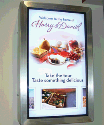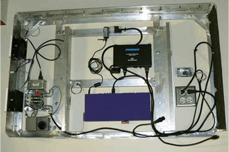Harry & David’s First Digital Signage System

The retailer reaches airline travelers in their hometown
When a brand new airport terminal opened in Medford, OR in early 2009, Harry & David, the nation’s leading retailer of fine food gifts, saw the prospect for a unique local marketing opportunity. As the region’s largest employer, Medford is “A Harry & David Town.”
At the end of the long arrival corridor stood a blank wall, never intended for advertising but a prime location nonetheless since all arriving passengers must go by it as they enter the terminal. Harry & David’s CEO, Bill Williams, spotted it and simply said, “I want that wall, and it needs to be video.”
Spectrum Systems Design of Portland, OR, researched and provided themain display elements, including a 46-inch Samsung LCD to be portraitmounted and, equally important, a non-PC display engine for the LCD.

Fast-forward a few weeks as the company’s internal television, creative design, and engineering departments sprang into action. Chris Robinson, director of Corporate Television who managed the project, summed it up like this. “The space was perfect for a digital sign with a captive audience viewing it. But it was fraught with challenges. We had to reconstruct the wall, choose a display system, encase it to protect the public, and do it all under the watchful eye of the TSA inside the secure area. And we had to develop content as well!”
Content creation started almost immediately. A creative team planned a repeating video loop in 1080p that catches the eye with appealing product shots and a call-to-action, urging visitors to take the company’s plant tour and “Taste Something Delicious.” Corporate producer Kenn Christenson set it against a bright white background that allowed the video’s visual elements to pop even in the high ambient light conditions at the airport.
Spectrum Systems Design of Portland, OR, researched and provided the main display elements, including a 46-inch Samsung LCD to be portrait-mounted, and equally important, a non-PC display engine for the LCD. This decision proved to be critical in that the display had to play video repeatedly in stunning high definition, be a hands-off operation, and recover quickly from power failures. Roku’s BrightSign HD2000 was the preferred choice for its value and ease of use. Although, initially, content was delivered by installing a CF card with the content and playlist, the BrightSign Network Manager allows continual content updating via a simple internet connection.
A daily selection of the top stories for AV integrators, resellers and consultants. Sign up below.
The crux of the installation however was the enclosure for the entire display. Because the sign could only be mounted at eyelevel, it was prone to accidental damage. To protect both the traveling public and the system components, the display needed to be housed in a sturdy, yet attractive enclosure. And it needed to match the style of the static advertising displays in the new terminal. Nothing on the market satisfied the requirements.
Fortunately, Harry & David has a very broad and talented internal engineering team. This group saved the day by designing and fabricating a fully functional yet beautiful wall-mounted aluminum frame and case for the system. Everything about this enclosure was custom made, from the LCD mount, to the radius curves of the frame’s edges, to the temperature control system inside the case. The frame’s cover swings out to allow easy access to the LCD and other components. Project manager Robinson says, “A lot of sweat and tears went into the enclosure. Lead mechanic Jimmy Fansler and his crew started with nothing more than a sample of the other advertising frames in the airport and some raw aluminum stock. In a few weeks they had a work of art that has the polish, look, and feel of the best digital sign enclosure I’ve seen anywhere. It really sets the LCD off nicely.”
Before the digital sign could be hung, the wall had to be remodeled to support the weight of the unit and add AC and internet connectivity. While this construction was taking place, the engineering teams were working on the enclosure while corporate television was revising the content and testing the devices.

Everything about this enclosure was custom made, from the LCD mount, to the radius curves of the frame’s edges, to the temperature control system inside the case. The frame’s cover swings out to allow easy access to the LCD and other components.
The corridor funnels every arriving passenger right past the sign, plus it can be viewed by those waiting for arriving passengers from near the airport gift shop, which just happens to be stocked with Harry & David’s tempting merchandise. The sign’s message is now playing brightly and without failure. Robinson says, “To the untrained eye, it’s just a beautiful video playing in a beautiful box.” The CEO’s response was equally beautiful, “Looks great!”
The AVNetwork staff are storytellers focused on the professional audiovisual and technology industry. Their mission is to keep readers up-to-date on the latest AV/IT industry and product news, emerging trends, and inspiring installations.
